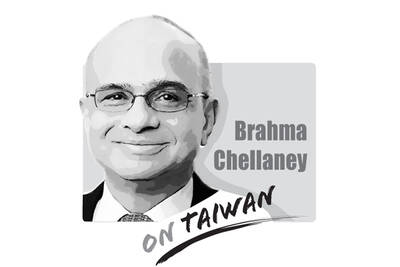Trying to force a partnership between Taiwan Semiconductor Manufacturing Co (TSMC) and Intel Corp would be a wildly complex ordeal.
Already, the reported request from the Trump administration for TSMC to take a controlling stake in Intel’s US factories is facing valid questions about feasibility from all sides. Washington would likely not support a foreign company operating Intel’s domestic factories, Reuters reported — just look at how that is going over in the steel sector.
Meanwhile, many in Taiwan are concerned about the company being forced to transfer its bleeding-edge tech capabilities and give up its strategic advantage. This is especially significant because this dominance not only keeps it ahead of industry rivals, but is also seen by many as the “holy mountain” that safeguards the nation from potential Chinese aggression.

Illustration: Tania Chou
On a more practical level, the two chipmakers are vastly different in everything from corporate cultures to manufacturing operations. TSMC revolutionized the industry with its pure-play foundry approach, Intel has historically produced chips it helped design. It would be a time-consuming and expensive headache for TSMC to take over Intel’s factories in the US or integrate them to its own.
It is not clear that this proposed tie-up would be enough to restore Intel’s glory. The Santa Clara, California-based company has already been showered with favor from the US government via policies aimed at strategically onshoring semiconductor manufacturing, but it has still been plagued with struggles.
As interim co-CEO Michelle Johnston Holthaus said on the most recent earnings call: “There are no quick fixes.” The company failed to effectively jump on the artificial intelligence (AI) boom and has been falling further behind rivals technologically, ending last year with its lowest revenue in more than a decade.
All this stands in contrast to TSMC’s strong performance. Even more remarkable: The two were roughly equal in value approximately five years ago, but the Taiwanese firm’s market cap now is some nine times that of its rival. TSMC previously seemed acutely aware of how difficult it would be to turn Intel’s fortunes around. Back in October, when Chief Executive Officer C.C. Wei (魏哲家) was asked if the company was interesting in acquiring Intel’s factories, Wei responded: “No, not at all.”
Although TSMC’s change of heart appears to have come as a result of a request from US President Donald Trump’s team, it is not going to change mounting challenges Intel is facing.
It is worth remembering how we got here. The reports of the joint venture emerged after Trump campaigned on the proposal of introducing tariffs to Taiwan’s chip industry to bring semiconductor manufacturing back to the US. However, Taiwan did not “steal” the industry; it got ahead by pioneering the made-to-order chipmaking business model that Silicon Valley had overlooked. This background is significant, because Trump has shown a habit of threatening tariffs as a negotiating tactic. In this case, his goal is restoring domestic chip production.
Tariffs, however, would not get that job done. TSMC would likely be able pass those costs onto customers, and its two biggest are firms at the heart of the US’ tech ambitions: Nvidia Corp and Apple Inc. The tech leaders that Trump has sought to maintain close ties with would not be happy to pay more for cutting-edge chips.
As influential technology analyst Kuo Ming-Chi (郭明錤) has pointed out, TSMC’s yearly chip exports to the US are worth less than its monthly revenue. Still, TSMC “cannot simply ‘accept tariffs’ and ignore Trump’s statements,” Kuo says, but knowing what the president ultimately wants could give TSMC some room to get ahead on its own.
The proposal of TSMC running Intel’s factories is still at very early stages. It is not even clear that Intel is open to the deal, which could involve other US chip design companies to counter concerns of foreign ownership.
TSMC’s representatives and the Trump team should find some middle ground that does not involve a complicated and costly tie-up with Intel. TSMC could start by offering up more investment into its existing US chipmaking efforts in Arizona. This would help meet Trump’s aim of winning back production while still allowing TSMC to keep its tech mastery in-house. When it comes to countering Beijing, TSMC and the US tech industry are on the same side.
The Taiwanese company’s chipmaking prowess is the best in the world, so many firms riding the AI wave are dependent on it. This makes the threat of tariffs seem like an empty or self-defeating move and provides the firm with significant leverage. However, there is always the danger that TSMC could lose that edge with a costly entanglement that threatens to dilute its dominance.
Catherine Thorbecke is a Bloomberg Opinion columnist covering Asia tech. Previously, she was a tech reporter at CNN and ABC News. This column does not necessarily reflect the opinion of the editorial board or Bloomberg LP and its owners.
I came to Taiwan to pursue my degree thinking that Taiwanese are “friendly,” but I was welcomed by Taiwanese classmates laughing at my friend’s name, Maria (瑪莉亞). At the time, I could not understand why they were mocking the name of Jesus’ mother. Later, I learned that “Maria” had become a stereotype — a shorthand for Filipino migrant workers. That was because many Filipino women in Taiwan, especially those who became house helpers, happen to have that name. With the rapidly increasing number of foreigners coming to Taiwan to work or study, more Taiwanese are interacting, socializing and forming relationships with
Whether in terms of market commonality or resource similarity, South Korea’s Samsung Electronics Co is the biggest competitor of Taiwan Semiconductor Manufacturing Co (TSMC). The two companies have agreed to set up factories in the US and are also recipients of subsidies from the US CHIPS and Science Act, which was signed into law by former US president Joe Biden. However, changes in the market competitiveness of the two companies clearly reveal the context behind TSMC’s investments in the US. As US semiconductor giant Intel Corp has faced continuous delays developing its advanced processes, the world’s two major wafer foundries, TSMC and

Earlier signs suggest that US President Donald Trump’s policy on Taiwan is set to move in a more resolute direction, as his administration begins to take a tougher approach toward America’s main challenger at the global level, China. Despite its deepening economic woes, China continues to flex its muscles, including conducting provocative military drills off Taiwan, Australia and Vietnam recently. A recent Trump-signed memorandum on America’s investment policy was more about the China threat than about anything else. Singling out the People’s Republic of China (PRC) as a foreign adversary directing investments in American companies to obtain cutting-edge technologies, it said
The recent termination of Tibetan-language broadcasts by Voice of America (VOA) and Radio Free Asia (RFA) is a significant setback for Tibetans both in Tibet and across the global diaspora. The broadcasts have long served as a vital lifeline, providing uncensored news, cultural preservation and a sense of connection for a community often isolated by geopolitical realities. For Tibetans living under Chinese rule, access to independent information is severely restricted. The Chinese government tightly controls media and censors content that challenges its narrative. VOA and RFA broadcasts have been among the few sources of uncensored news available to Tibetans, offering insights